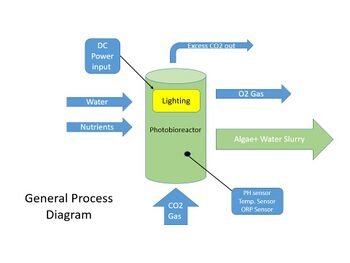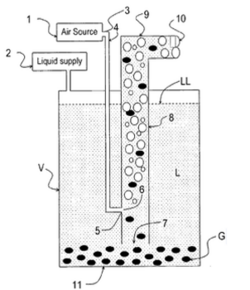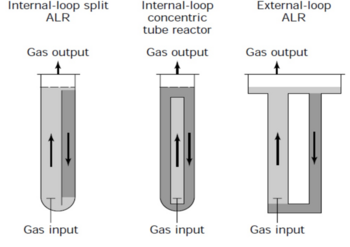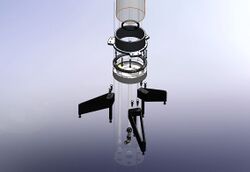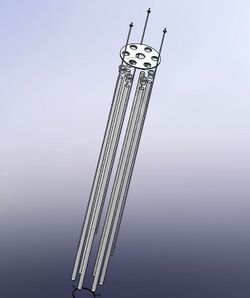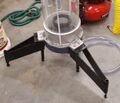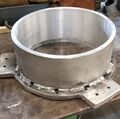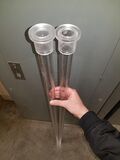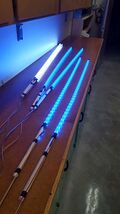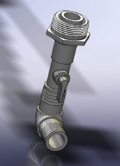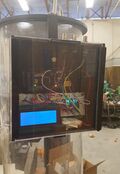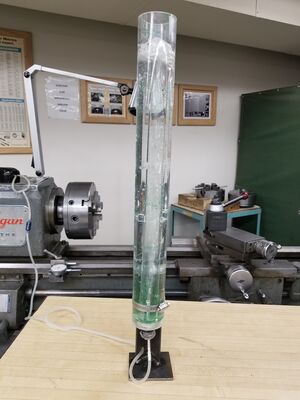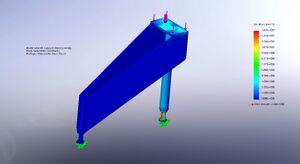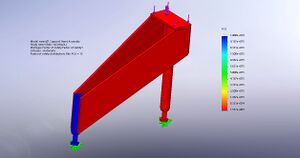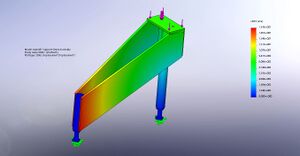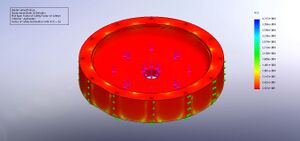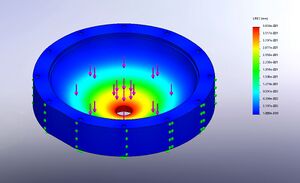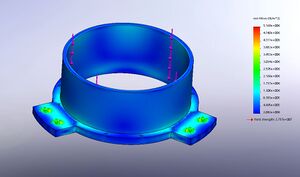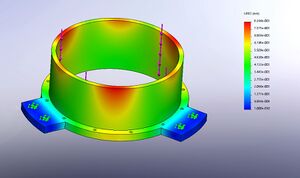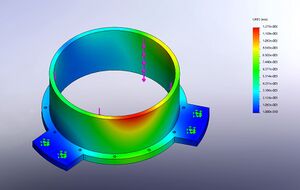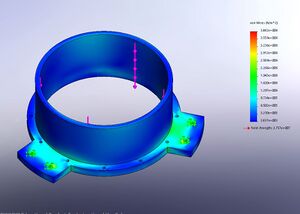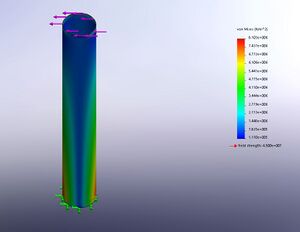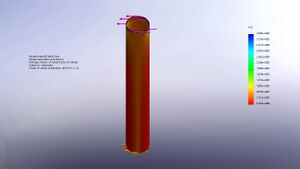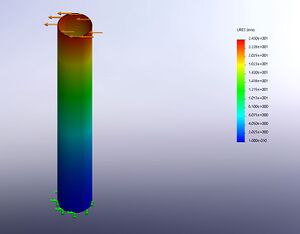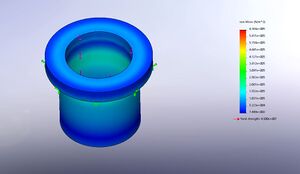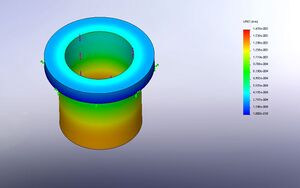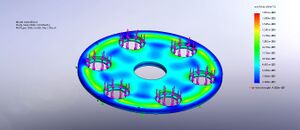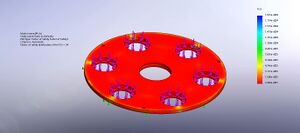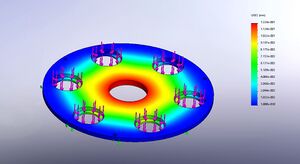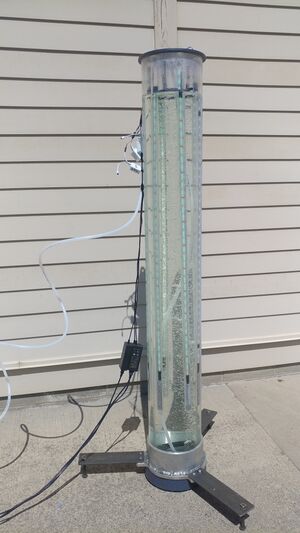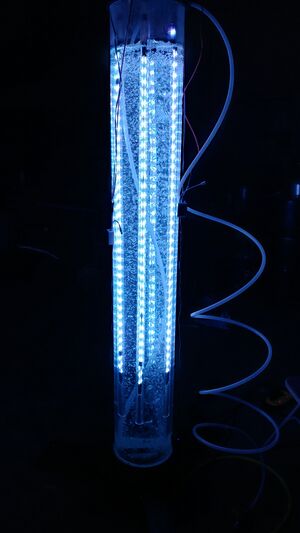Photobioreactor for Microalgae Cultivation
| Sponsors | |
| Team Members | |
| Duration | Fall 2017 - Spring 2018 |
| Mentor | Dr. Dev Shrestha |
The goal of this project is to build a bench scale air lift photo bioreactor for micro algae cultivation. Micro algae is an excellent resource with wide reaching applications, from waste water purification to biodiesel production. We have designed a system capable of producing micro algae in a cost effective, reliable, and efficient manner by utilizing an airlift style reactor design with LED lighting. This page provides an overview of the project's background, our design, our design rationale, and the validation of the design. A video of the device running can be found here
Problem Statement[edit | edit source]
Background[edit | edit source]
Photo Bioreactors are devices often used to produce micro algae commercially. Some of the challenges of photo bioreactor design are supplying sufficient light to the micro algae and preventing the micro algae from sticking to the sides of the bioreactor. There are a range of designs currently in use, including open ponds, water filled flexible plastic bags, and long glass tubes. Each of these have issues, either with light penetration, cost, or reliability. An airlift design that solves each of these issues effectively is the goal of this group, since they are inherently low power, low maintenance devices. The completion of this project will enable the culture of most microalgae to be used for research purposes in the fields of biofuel generation and environmental impacts in an efficient and cost effective manner.
Design Task[edit | edit source]
Our task is to design a bench scale airlift photo bioreactor for research purposes. It should be designed to maximize efficiency and minimize cost, and thus should be composed of relatively inexpensive materials. The basic design should be such that it could conceivably be scaled up and built of more durable materials such as stainless steel.
Design Specifications[edit | edit source]
| Specification | Unit | Metric | Explanation | |
|---|---|---|---|---|
| 1 | Minimized energy input | kW-hr | Minimum | The design should attain the highest output possible for the amount of energy used |
| 2 | Capable of microalgal cultivation | - | - | The design must be capable of efficiently cultivating the growth of microalgae |
| 3 | Observable/ display capable | - | - | The basic functions and components of the PhotoBioreactor should be visible from the exterior of the device. |
| 4 | Uniform Nutrient Distribution | ppm | - | The nutrients vital to algal growth must be distributed evenly throughout the volume of the bioreactor. |
| 5 | Minimal dead volume | Gallons | Minimum | Areas of stagnant water should be minimized or eliminated |
| 6 | Maximum efficiency of light utilization | kW-hr/Lumen | Maximum | The lighting system should provide the maximum usable light to the microalgae with minimal power usage. |
| 7 | Controllable light intensity | - | - | The lighting system must have easily controllable intensity and frequency |
| 8 | Artificial Light source | - | - | For this project, the necessary light must be provided by an electrical lighting system. |
| 9 | Uniform light distribution | - | - | The light levels in the bioreactor should be as uniform as possible throughout its volume |
| 10 | Light source must comply with relevant standards/codes | - | - | Any codes regarding electrical safety, etc. must be observed. |
| 11 | Carbon Dioxide introduction system | - | - | The system must be capable of adding CO2 vital to algae growth without excessive waste of gas |
| 12 | Controllable Carbon dioxide flow | m^3/s | - | The rate at which CO2 is introduced should be adjustable by a regulator |
| 13 | CO2 flow promotes medium circulation | m^3/s | - | The mode of introducing CO2 to the bioreactor should also serve to provide the necessary flow for mixing and dead space elimination |
| 14 | Working Volume | Gallons | 10-15 | The design specifications call for a total working fluid volume between 10 and 15 gallons |
| 15 | Control Sensors (PH,CO,Nitrate etc) | - | - | Sensing equipment should be able to measure metrics relevant to growth of algae such as PH |
| 16 | Visual Appeal | - | - | The design should be as aesthetically pleasing as possible without detracting from its effectiveness |
| 17 | Scalability | - | - | The basic design of the bioreactor should have potential for scaling to larger volumes and production. |
Project Learning[edit | edit source]
MicroAlgae Requirements[edit | edit source]
For our project, we needed to be very adaptable with the parameters microalgae need to survive. This is because the PBR needs to grow many different types of algae without major modifications to the physical design. To generalize our PBR’s capabilities, we decided to use a common microalga as a control for all the needed parameters. The Algae we chose to find these parameters is the Chlorella varieties. These species are very common green microalgae found worldwide in all types of water. Most grow best with high ambient light up to 2000 umol/m2s with wavelength of blue and red. They also thrive well in temperatures of 74-80 degrees Fahrenheit, and at a pH between 6.8-7.2. CO2 concentrations should be kept no less than 22 ppm, and greater values are acceptable.
Flow Considerations[edit | edit source]
Over the development of this project we found that it is hard to find fluid flow models around the sort of system we are working with, involving a bubbling gas flow inducing a liquid flow. We found empirical equations in a book titled "Air-Lift Bioreactors" by M. Y. Chisti. We have attempted to create a math model in TKsolver using these equations to optimize flow velocity and gas holdup. However, we have found for the most part due to the number of unknown variables we will need to actually construct the reactor before we can glean any meaningful data from it. Part of the purpose of this reactor is as an experimental prototype from which this sort of data can be taken.
Design[edit | edit source]
Design Selection[edit | edit source]
The problem as it was given to us allowed a lot of room for creativity. There are a variety of possible designs for an air lift reactor, including external loop airlift, flat internal loop, and concentric internal loop. In selecting a basic design, we needed to consider a variety of factors, such as cost, flow, and ease of construction and maintenance. Below is a basic breakdown of the pros and cons of each basic design, and the rationale behind the one we chose.
External Loop
- Pros: Easy to maintain.
- Cons: Flow is less than optimal, the design is slightly more difficult to construct.
Flat Internal Loop
- Pros: Easy to construct, maintain, and adjust.
- Cons: Sub optimal flow (potential dead spots)
Concentric Internal Loop
- Pros: Easy to construct, excellent flow characteristics
- Cons: Less flexible design.
We ultimately selected the concentric internal loop design as it both provided the features we deemed most important and fit well with the wishes of our client.
Alternative Designs[edit | edit source]
We initially considered the flat internal loop design for reasons of ease of construction and versatility. This design was composed of two transparent sheets of acrylic with an exchangeable flow guide placed between. The sheets would then be clamped down together, creating a box of sorts with the working fluid volume flowing between the two panels. This design was ultimately discarded due to concerns from our client that the rectangular cross-section of the flow channel would cause stagnation issues. Later on in the project, we considered adding baffles above the riser tube in order to improve fluid mixing, ultimately deciding not to in order to keep the design as simple as possible.
Our Design[edit | edit source]
Our design utilizes a concentric internal loop style airlift system for the circulation of the slurry in our photo bioreactor. It is composed of an outer cylinder(downcomer) made of 10" diameter clear acrylic tube and a 6" diameter inner tube(riser). The suspension of algae and water flows up the inner cylinder, driven by the flow of CO2 bubbles from a gas diffuser (sparger) mounted in the riser tube, which is connected to a tank of CO2. The base of the bioreactor is made of a block of Nylon plastic which was machined to a contour that was designed to reduce flow stagnation (dead spots) and improve flow, as shown below. This block is sealed in place by the means of an aluminum flange which is attached to the outer tube of the reactor with silicone adhesive caulking. This allows the bioreactor to be partially disassembled for cleaning or later modification. Lighting is provided by waterproof, tunable RGB LED strips enclosed in 6 thin vertical tubes arranged in a radial pattern about the inside of the outer tube. The lighting system is controlled by infrared remote controls to allow for customization of the color and intensity of the light wirelessly. A sensor system was also included with the reactor allowing for the measurement of pH within the Riser Tube and Downcomer Tube. An ORP sensor was also included as opposed to a dissolved CO2 sensor due to budget constraints. A nutrient solution would be introduced in to the reactor through the lid using a peristaltic pump. This pump could be calibrated to each specific algae strain desired to maximize efficiency. CAD models of the system are shown to the left.
| Team "Autophyte Activators" | |||||
|---|---|---|---|---|---|
| Component (Click Thumbnail for Expanded View) | Description | Materials | Construction | Specifications | Validation/Testing |
| Stand | The stand provides stability for the bioreactor and clearance for the drain valve on the base and is adjustable to insure the reactor is standing upright | Steel | Welded together from .25" flat stock and tubing | Must hold weight of fully filled reactor (~ 250 lbs) without buckling or warping | Maintained stability under load. FEA analysis showed factor of safety of over 33. |
| Base | A plastic base for the reactor bolts to the flange. A bowl shaped contour on one side facilitates smooth flow and prevents dead spots | Plastic | Machined on CNC Lathe | 10" diam. 2" height | Maintained seal when reactor was filled. Provide necessary flow characteristics |
| Gasket | A custom cut rubber gasket that fits between the flange and the base to provide a full seal. | Neoprene sheet | Hand cut with a template | 0.125" thickness | Maintained seal when reactor was filled. |
| Flange | A custom fabricated flange that glues directly to the large down comer tube to provide a good seal. Bolts to the base with a rubber gasket in between. | Aluminum | Welded from Plate stock and large diameter tubing | 10" ID 0.64" thick base plate. 12 boltholes, three tabs for mounting to stand. | Maintained seal when reactor was filled. |
| Exterior Tube | A 10" diam. clear acrylic tube that forms the main body of the reactor and provides the flow channel for the descending fluid. | Acrylic | Purchased | 10" OD, 6' long, 1/8" Wall thickness | Fit with all necessary components, provided necessary flow characteristics. |
| Interior Tube | A 6" diam. clear acrylic tube that provides the channel for the bubble column and ascending fluid. | Acrylic | Purchased | 6" OD, 5' long, 1/8" Wall thickness | Fit with all necessary components, provided necessary flow characteristics.File:2018 autoph Wikipage Fluid Flow Animation.ogg |
| Riser Supports | A set of braces to hold the interior tube in place while allowing fluid to flow around them relatively unhindered. Threaded ends allow for easy adjustment by moving thread couplings in and out. | Steel | Welded ring with bolts attached to allow for tightening in place | 6"ID 1/16" thick ring | Fit with all relevant components |
| Light Tubes/Connectors | A 1"diam. clear tube sealed at one end to contain the light fixtures, with a step cut plastic attachment at the open end made to hang in purpose cut holes in the lid. To prevent them from floating when the reactor is filled, the bases are weighted with steel shot | Acrylic | Tubes were purchased and sealed with small discs of acrylic at their base. Connectors at top were machined out of round stock acrylic and solvent welded on. | 1.25" OD 5'Long | Maintained seal when immersed, fit with all relevant components |
| Light Fixtures | A series of light fixtures made to fit inside the light tubes, with full spectrum capability provided by adjustable water resistant RGB LEDs | Wooden supports, LED strips | Light fixtures were fabricated from square wooden rods with RGB LED strips glued on all four sides. | 120 Watts Power Total. Water resistant light strips | Demonstrated function under running conditions. |
| Sparger | A sparger which introduces gas into the system through small diameter bubbles | Rubber | Purchased | 6" diam. 1" thickness | Demonstrated function under running conditions. Fit with relevant components |
| Lid | A lid for the reactor that serves both as a mounting point for the electronics box and the light tubes, and prevents some splashing and overflow from the bioreactor. | Plastic | Machined on CNC lathe from plastic sheetstock | 11" diam. 0.38" thickness. | Fits with all relevant components |
| Drain | A fixture which allows the bioreactor to be drained quickly and easily by opening a ball valve. | PVC | Assembled with thread tape from purchased components | 1" NPT fittings, coupling, ball valve, hose barb. | Fits with all relevant components, drains rapidly. |
| Sensors | A series of chemical sensors controlled by an Arduino Mega. Measurements are displayed on a small LCD screen attached to the reactor. | N/A | Electronics box was solvent welded together from sheet plastic. The sensors and electronics were purchased. The circuit was assembled on a breadboard. | Measures PH at two locations and ORP (oxidation reduction potential) | Demonstrated to take and display measurements reliably |
Concept Testing[edit | edit source]
This prototype was made to demonstrate the mode of operation that the airlift system utilizes to generate circulation. Due to the geometric similitude to the full scale model, it was also used to confirm some of the decisions made to choose certain features for the final design. It was also used it to test different sparger designs, since information on the performance of different types was not available. It was concluded from testing that the system would require a style that had much smaller perforations than could effectively be simulated with the scale of the system reduced as much as it was. This information helped inform the decision for what type of sparger would ultimately be used, one with the smallest possible perforations, in order to promote the most even distribution of gas as well as the best absorbtion of it by the algae.
FEA Analysis[edit | edit source]
| Component | Stress | Factor of Safety | Displacement | Parameters | Safety Factor | Displacement
|
| Stand | 100 lb compression loading. Moderate mesh | 15 | 0.16mm
| |||
| Base | 250 lb applied over center. Moderate mesh | 26 | 0.38 mm | |||
| Flange
(Compression Load) |
250 lb compression | 5.3 | 0.008 mm | |||
| Flange
(Side Load) |
250 side load. Moderate mesh | 7.1 | 0.013 mm
| |||
| Exterior Tube | 150 lb side load at top. Moderate mesh | 5.6 | 0.24 mm | |||
| Light Tube Connectors | 20 lb applied at hole. Moderate mesh | 73 | 0.0017 mm | |||
| Lid | 20 lb applied each hole. Moderate mesh | 24 | 0.122 mm |
Testing[edit | edit source]
Leak Testing showed no detectable leaks. Initially the light tubes showed a tendency to float upward out of their place, however this was easily rectified by adding weight at their base. In order to check flow characteristics small beads at nearly neutral buoyancy were added and the bubbler was attached to a small air compressor. The flow pattern shown was the same as intended in the initial specifications, thus showing the success of the design. Rudimentary flow speed testing, accomplished by timing the travel of a bead in the flow over a set distance, showed particle movement speed of 4" per second at the lowest pressure setting, well under 20 psi. The sensing equipment takes and displays readings as designed.
Design Validation[edit | edit source]
| Specification | Unit | Metric | Results | |
|---|---|---|---|---|
| 1 | Minimized energy input | kW-hr | Minimum | TBD by Client |
| 2 | Capable of microalgal cultivation | - | - | TBD by Client |
| 3 | Observable/ display capable | - | - | Transparent main components |
| 4 | Uniform Nutrient Distribution | ppm | - | Uniform flow provides mixing |
| 5 | Minimal dead volume | Gallons | Minimum | Uniform flow eliminates most dead spots |
| 6 | Maximum efficiency of light utilization | kW-hr/Lumen | Maximum | TBD by Client |
| 7 | Controllable light intensity | - | - | The lighting system controls allow for dimmable lighting |
| 8 | Artificial Light source | - | - | LED strips provide lighting |
| 9 | Uniform light distribution | - | - | All direction LED light fixtures should provide uniform coverage |
| 11 | Carbon Dioxide introduction system | - | - | Bubbler at base of riser allows for CO2 introduction |
| 12 | Controllable Carbon dioxide flow | m^3/s | - | Can be adjusted at gas regulator |
| 13 | CO2 flow promotes medium circulation | m^3/s | - | Airlift flow demonstrated |
| 14 | Working Volume | Gallons | 10-15 | Fulfilled |
| 15 | Control Sensors (PH,CO,Nitrate etc) | - | - | ORP and PH sensors give regular measurements |
| 16 | Visual Appeal | - | - | Positive verbal feedback at Expo |
| 17 | Scalability | - | - | The design has no factors preventing scaling up |
The Team[edit | edit source]
| Team "Autophyte Activators" | |||||
|---|---|---|---|---|---|
| Member | Biography | Discipline | |||
| Lucas Becia | A fifth year senior studying Biological Engineering from Boise, Idaho. I have played soccer my entire life including one year of college soccer at South Dakota School of Mines. I would like to work in alternative energy when I graduate. | Biological Engineering | |||
| Samuel Funk | My name is Samuel Funk, I am currently a fourth-year student in Biological Engineering at the University of Idaho. I am the son of two teachers and grew up in Lewiston Idaho. In the future I hope to work in the Biomedical industry, where I would like to work in the implementation and development of diagnostic medical imaging devices, or regenerative medicine. | Biological Engineering | |||
| Matthew Jungert | Currently completing my 5th and final year at the University of Idaho in Biological Engineering. I grew up on a family farm/ranch in Cottonwood Idaho. I currently work in the Lab Animal Research Facility on the University of Idaho campus as a Lab Animal Technician. I plan on going into the fields of precision irrigation or bioenergy. | Biological Engineering | |||
| Sage Pratt | I am a mechanical engineering student from Moscow, Idaho. I chose this educational path due to my general interest in technology and science. I am also enrolled in the Air Force ROTC program, and plan to commission as a 2nd Lieutenant upon graduation and work in space operations. In my free time I attend a bible study at my church, read extensively, and work on metal and woodworking projects in my garage. | Mechanical Engineering | |||
| Nate Wiedenmeyer | I’m a Senior in the College of Mechanical Engineering from Coeur D’Alene, Idaho. I chose this project since I am interested in combustion systems and wanted to learn more about fuels and how the guys I saw growing up turned the old fry oil they got from restaurants for free into an effective petroleum fuel substitute. | Mechanical Engineering | |||
Document Archive[edit | edit source]
Report[edit | edit source]
Presentations[edit | edit source]
- Fall Semester Design Review (Fall 2017)
- Spring Semester Design Review (Spring 2018)
- Expo Presentation(Spring 2018)

